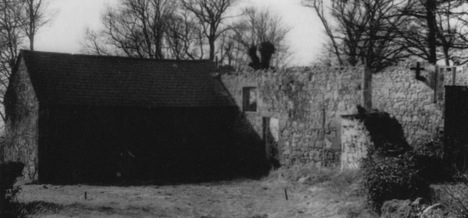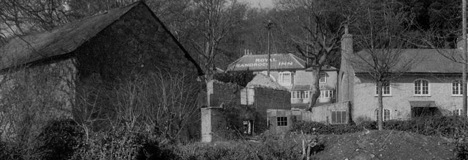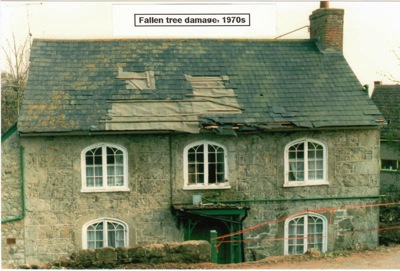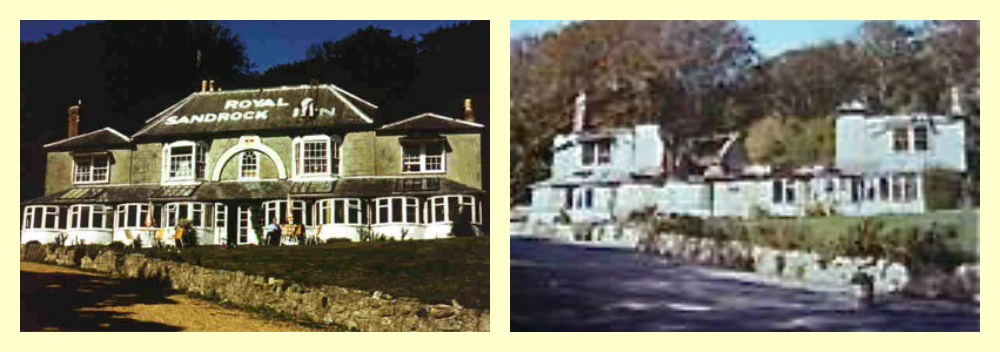Emergence of the Sandrock Hotel
Despite accounts that suggest that The Sandrock was built as a hotel it seems clear from the evidence of the title deeds, which refer to the property as a messuage, not as a hotel, that it was originally constructed as a private residence.
In any event, the property was acquired by two brewers from Newport, James Cull and John Abraham, who it is said recognised the commercial potential of its location and converted it for use as an hotel.
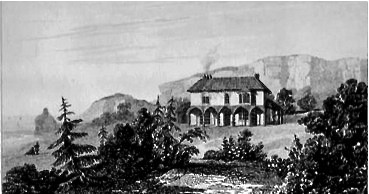
It appears that the new owners then enlarged the building by adding two new wings. This extension work would have to have been during or after 1812, the date on a W.B. Cooke print showing the Sandrock in its smaller, wingless format.
It is W.B. Cooke who most clearly recites the origins of the hotel, stating
5:
“It was originally built as the private residence of a gentleman of taste and fortune, who greatly admired the wild scenery of the Undercliff. It was afterwards purchased to be converted into an hotel- hence, it has more the appearance of a decorated villa, rather than a house of public resort”. Cooke continues enthusiastically: “ The grounds are kept in beautiful order, and are enriched with flowerbeds, and with choice creepers clinging to the rocks. The veranda in front of the house is supported by ten rustic pillars, entwined by twisted branches of ivy over-running the top, affording to the visitors a delightful shelter from the rays of the mid-day sun.”
The Sandrock Chalybeate Spring
The impetus for the conversion of the Sandrock into a hotel was the discovery in 1808 of a chalybeate
6 spring by a Newport surgeon, Thomas Waterworth.
THE SAND-ROCK-SPRING-COTTAGE
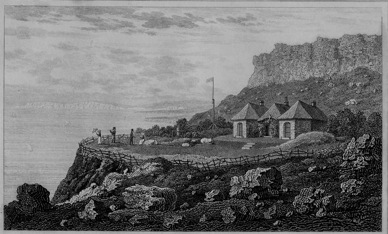
From the first edition of G. Brannon’s
Vectis Scenery, 1827
“Situated above the albuminous
chalybeate spring, the property of
T Waterworth Esq.”
The site of the sandrock chalybeate spring was about half a mile to the west of the Sandrock, towards Blackgang
7. The Sandrock Spring Cottage was built as a dispensary for visitors, located above the springhead, where a grotto was built to enhance and protect the source. The spring water was commercially exploited as a cure for many ailments and enthusiastically extolled as a cure all. A typical example is Barber’s Picturesque Illustrations of the Isle of Wight, 1846 which tells the potential visitors that:
”[the water] possesses the properties of a tonic of the most powerful kind and has been found singularly efficacious in the cure of many very important and dangerous diseases..” including “tremblings, with all the varieties of nervous and hypochondriacal disorders”8
Sand Rock Spring Cottage ceased dispensing its spring water although we can deduce that the spring continued to flow, no doubt contributing the destruction of the building, which finally disappeared in a landslip in 1979. The location of the site of the spring has been lost with subsequent land movements to the west of the vast landslip area to the west of Windy Corner.
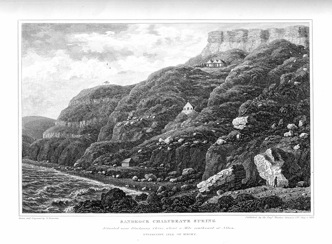
The Sandrock Chalybeate Spring
(with the dispensary or Spring Cottage shown above);
situated above Chale Bay,
a little to the west of Rocken End.
The area was and is still a landslip
Original use of the Rock Cottage
As indicated above the cottage and stables were constructed as part of the development of the Sandrock (a thriving hotel needed extensive stabling for visitors and also outbuildings in which to house staff). From 1814 the cottage was conveyed with and as part of the Sandrock’s estate buildings.
The first use of the cottage was as the tap house for the hotel and this is also reflected in the descriptions in the deeds for the Sandrock. Prints in George Brannon’s early promotional travel books on the Island clearly describe the cottage as the tap for the hotel
9.
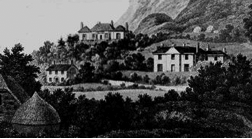 A detail from the plate in Vectis Scenery, ibid
A detail from the plate in Vectis Scenery, ibid

The Sandrock became a coaching inn on the road from Ventnor to Freshwater, and as such was an important part of the transport infrastructure of the Undercliff. Coaching inns were used as stopping places for the regular daily passenger coaches and provided stabling for horses.
10 Drivers of coaches to the hotel would pull up to rest or change their horses and take a draught of ale or small beer at the tap.
The Sandrock was apparently also a “post house”, that is an inn where horses were kept for post riders or for hire to travellers.
Evidence of early use as the tap
Apart from the Brannon prints and the title deeds to the Sandrock, there are a few other surviving clues to the original use for Rock Cottage. One can be found in the ample cellar, which contains large stone ramps to aid the lowering of barrels of beer into the cellar. These buttress-like ramps have regular recesses cut into them that housed the removable wooden struts to hold the barrels.
The large gable end and road facing walls at the west end of the cottage are the only remaining parts of the stable and coach house buildings. These were clearly substantial structures. The coach house survived until the 1970s, when it was converted into the house now known as Sea Rock.
11
During the course of the restoration of Rock Cottage a flint cobbled yard was uncovered, at a depth of about 30cms under the garden,12 which was lifted and restored for use in situ as a small vehicle hard standing and in the path on the stone terrace from the rear south door of the cottage. Further traces of the flint cobbles continue to lie under the garden and the newly laid flagstone terrace.
Another legacy from the 19th century use as a tap house and the adjoining stables is the large stone coach stand just across Sandrock Road almost opposite the cottage, from which, we deduce, passengers would alight for the hotel.13
Location of Rock Cottage in context
Until the Great Landslip at Windy Corner in 1928, Sandrock Road was, as indicated above, the “main” road from Ventnor to Blackgang. In reality, until the end of the eighteenth century this road was little more than a pack-horse trail, although it underwent significant improvements from the end of the eighteenth century, which enabled it to support the increased traffic along the Undercliff. It can be speculated that these improvements may have prompted the development of the hotel.
It was also around this time that the road to Niton village, Barrack Shute, was opened, enabling direct vehicular traffic between Niton and lower Niton, or Niton Undercliff.14
St Catherine's Road was only constructed in the mid nineteenth century with the building of the lighthouse in 1840 and the development of the land on which St Catherine’s House and the properties of St Catherine’s Terrace.
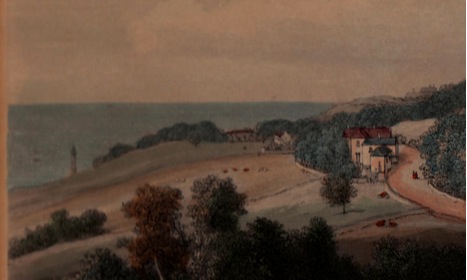
Detail from "THE UNDERCLIFF AT NITON."
above the new Lighthouse
drawn & engraved by W.Westall, A.R.A.
First Hand Account of Niton from the Nineteenth Century
Mark Norman was an Islander who kept a diary until 1898 and wrote very lucidly about his early years living in Niton in the 1830s. He was born into a poor household and although neglected by his parents who had moved to London he returned to the Island.
15 According to the fascinating account of his adventures Norman, whose mother had died of unspecified causes, had been abandoned by his alcoholic father as a 12 year old at the Elephant and Castle in south London, given half a crown and told to walk to the Isle of Wight to live with his grandparents in Newchurch.
16 Self educated, Norman was involved with the radical chartist movement, was a founder of the Ventnor Scientific Institute and a keen geologist.
Norman’s first job was as an ostler (a stableman) at the White Lion in Niton, at that time (it must have been soon after the end of the Napoleonic wars) billeted by soldiers. The village he described was self sufficient, with all the necessary tradesmen, fishermen, the manor farm and other smaller farms in and about the village. Norman was taken into the heart of the community and participated fully in its lively social activities including the “select parties”, village balls and the mackerel fair.
Niton also benefited from its “time honoured” trade of running contraband spirits, principally brandy and “proof spirit” from the Normandy coast, known euphemistically as participating in a “cross Channel adventure”. According to Norman the smuggling profession involved most of the village, either as active participants in running goods, buying them from homeward bound ships in the Channel or as “sleeping partners” or financiers for the cross Channel adventures. The trade was sophisticated, involving 50 ton wherries, sailing at night and running the gauntlet of Revenue cutters and gun brigs which patrolled the Channel. Niton’s strategic position in the illicit trade is evidenced by it having a coastguard station and lookout building.
17
The smugglers and coastguards all along the coast engaged in a dangerous war of attrition and often the poorly paid coastguards were bought into the trade.
18 For a quaint 1950s representation of the different modes of storing and handling the large barrels of liquor on board the smuggling ships see the murals in the barn at the Buddle Inn.
Norman’s uncle was a mason and he describes his first job as clearing some large rocks “that encumbered a garden opposite the Sandrock Hotel”
19 and so Norman would have been very well acquainted with the Sandrock Hotel, and with Rock Cottage and its inhabitants.
Intemperance in Niton
According to Mark Norman, Niton was at this time “famous for drinking and carousing of its inhabitants”. The favourite drinking house was the Buddle Inn, just down the path from Rock Cottage, which in addition to selling beer at fourpence a quart purveyed a variety of lethal concoctions. At the top of the beverage list was an “egg flip” which comprised a quart of ale, a dozen eggs and a half pint of brandy heated over the fire and served hot. Perhaps the flip describes the reaction of the drinker rather than the contents of the brew. Another popular concoction was beer and brandy served cold (without eggs), known as a “dog’s nose”.
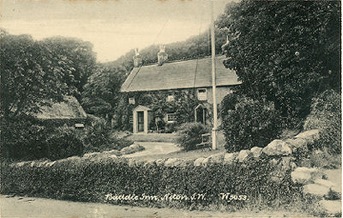
Mark Norman wryly observes:
“the drinking habits of the Undercliff were at that time quite habitual and in general entered into almost any transaction of life....In fact intemperance was the rule and temperance the exception.”
The Buddle Inn, on an early 20th century postcard; still a thriving drinking house
The Buddle was not the only unlicensed drinking place; the upper village had several more including the Goose (at what is now St Catherine’s Hall), the Cat and Rabbit, whose location is forgotten, as well as the Star Inn (still a pub until the late 1960s) and the White Lion Inn, the only remaining pub in upper Niton.
The Ostler of the Sandrock Hotel in the 1830s
Mark Norman often talked with the ostler of the Sandrock Hotel while in the Buddle Inn. Jacob Attrill seems a colourful character: bald headed, with over hanging eyebrows and of stout build, dressed in white frock, ornamental puckers and light cords encased in nailed lace up boots.
Attrill was often seen standing, bald head shining, hat in hand by the vehicles waiting for the gratuity for stabling and looking after the horses at the stables by Rock Cottage. Carriages and “one horse flys,” capable of accommodating four passengers in addition to the driver, were frequently in use, running between Bonchurch, Ventnor and Blackgang and onwards to Freshwater in West Wight.
20
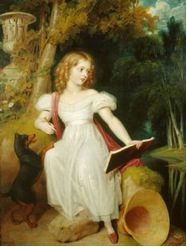 Visit to the Sandrock of Queen (then Princess) Victoria
Visit to the Sandrock of Queen (then Princess) Victoria
There are various accounts of Princess Victoria visiting the Sandrock and the reliability of some dates is questionable. Jacob Attrill is said
21 to have been patronised by the Duchess of Kent and her daughter Princess Victoria and describes them as having made “frequent visits” to the Sandrock Hotel, which subsequently advertised its Royal prefix. We are fortunate that Queen Victoria maintained a journal for most of her life. Enquiries of the Senior Archivist of the Royal Archives, Windsor Castle, reveal that the Princess and her mother stayed at Norris Castle in 1831 and 1833 at Norris Castle in Whippingham near East Cowes, close to where she later built Osborne House with Prince Albert.
Princess Victoria in 1830, by Richard Westall, the Princess’s drawing master22
Another source 23indicates that the Duchess and her daughter stopped at the hotel on Saturday 13th July 1834, to take refreshments.
Niton Calling24 also records that Victoria, as a girl of 15 (which, as she was born n May 1819 would be consistent with a visit in July 1834) “stayed there with her mother, the Duchess of Kent in order that they might drink the waters from the Sandrock spring not far away”.
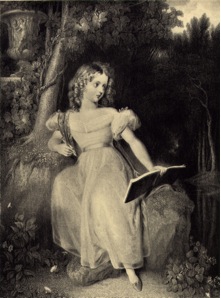
The Princess did not start writing her Journal until 1832, so we only have access to her Journal for her later visit to Norris Castle. One reference is made of the Princess’s visit to the Sandrock, on the 10
th July, 1833:
“…At ½ past 10 we went with Alexander, and Ernst, [her cousins] in our carriage, and Lady Conroy, Victoire, Lehzen, following, to Sandrock Hotel, a pretty little inn on the back of the island. We got there by ½ past 12. We lunched there. At ½ past 2 we returned…”
An adaptation of the same Westall painting of Princess Victoria, published as an engraving in 1834
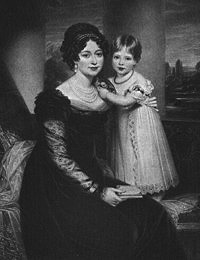
Victoria, Duchess of Kent (Mary Louise Victoria of Saxe-Coburg-Saalfeld)with her daughter Princess Victoria
It would appear that Princess Victoria had holidayed on the Island with her mother two years before their 1833 visit to the Sandrock recorded in her journal and travelled to the Undercliff25. The contemporaneous account of John Green, a parish clerk of St Lawrence tells us:
“In 1832, their Royal Highnesses the Duchess of Kent and the Princess Victoria visited the Right Honourable Earl of Yarborough at a public breakfast on the lawn. They came round in the Royal Yacht, and several of the Royal Yacht Squadron followed their noble Admiral’s Yacht, which accompanied their Royal Highnesses to St. Lawrence Bay, near the fort, and a Royal salute was fired and due homage paid by all. This was a more pleasant sight than such as used to be seen in time of war.”
It is not known if their Royal Highnesses also took the opportunity on this occasion to visit the Sandrock or the spring, a few miles to the west of St Lawrence. Local tradition has it that her early visit to the Sandrock Hotel influenced Victoria in her choice of the Island as her home.
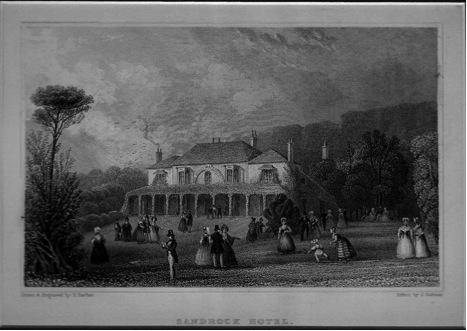
Sandrock Hotel from Barber, 1850
Census evidence, 1841-1911
In 1841 Rock Cottage is separately listed and occupied by the Whittington family. Jacob Attrill is revealed as living in the Well House (at the junction of Sandrock Road and Barrack Shute), 50 years of age and still an ostler, at the head of a family of no less than eight children..
He who is likely to have retired or have died by the 1861 census which shows Isaac Whittington and his wife
Leah as still resident at Rock Cottage in 1861 with Whittington as “ostler”. Over the period the Whittingtons brought up at least six children at the cottage. Whittington is still listed as ostler in the census of 1871 (aged 60) and his son John, then 22, as a waiter. Whittington’s wife Leah is no longer listed.
By 1901 the property seems to be in new use and the census confirms the view that it housed an early telephone exchange for the hotel, with the head of the family, the widowed Mary Green described as “attendant, telephone office”, and her daughter Alice a dressmaker. Curiously, Mary Green shared her name with the owners of both the hotel and the cottage, Frank and Mary Green but was not related. Mary died in 1902 and Alice looked after her two younger siblings Edward and Frederick for another year until they went into an orphanage and Alice vanished without trace little more is known of her other than she worked as a seamstress in Ventnor and traded on her “own account”.
The cottage was in 1891 occupied by Alfred Richards, gardener, his wife and their six children.
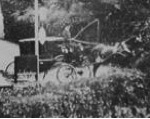
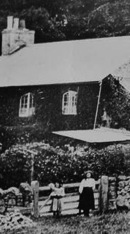
The 1911 census form is signed by Arthur Butt (aged 37) who is a ‘carriage proprietor’ a
nd Annie his wife (also 37) is a telephone operator and so it appears that the cottage was still being used as the switchboard for the hotel
.
The little girl in the postcard (we have originals posted in 1912 and 1913) may be Ida or Marian with her mother, or possibly features the two girls.
Their son Walter (16) was a "carriage driver". There was also another son, Charlie (10) and two daughters, Marian (7) and Ida (12).
It was at the turn of the century that Guglielmo Marconi stayed at the hotel while conducting early radio experiments at Knowles Farm, at the cottage now named Marconi Cottage.
The attractive cover photograph in the form of a postcard of unknown date, probably during the early 1900s, describes the cottage as the “Niton Undercliff Post Office”.
Decline and fall of the Sandrock
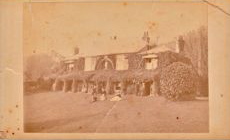
The Sandrock Hotel fell into a period of decline during the mid nineteenth century but had evidently recovered by April 1891 when the census shows Rudyard Kipling as resident. He was by then already a celebrated author. He visited with his American friend and fellow author and collaborator, Wolcott Balestier26.
Sandrock Hotel c 1870
The Sandrock fell into decline after World War Two but continued to perpetuate the local custom of carousing and intemperance well in
Ten years later Marconi stayed at the hotel while conducting his celebrated radio experiments at Knowles Farm, at the cottage now called Marconi Cottage.
to the 1960s and 1970s, when it happily dispensed the often catalytic Burt’s bitter in conditions of decayed colonial elegance and became a popular boisterous venue for live rock music.
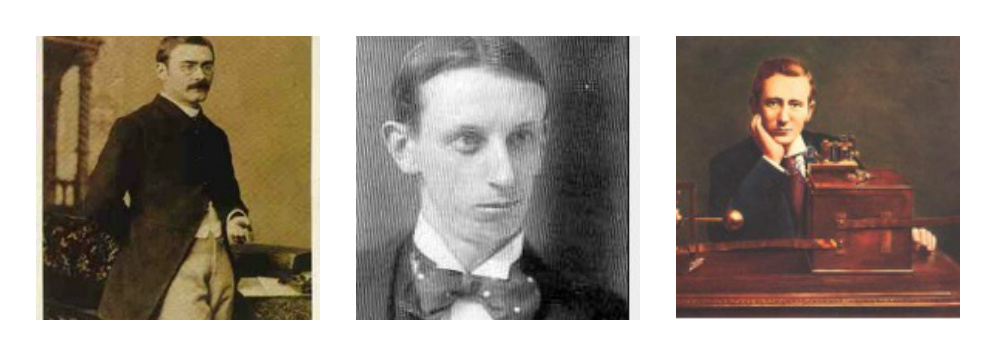
Rudyard Kipling, c 1897 Wolcott Ballastier Guglielmo Marchese Marconi
the “father of radio”, founder of the Marconi Company and joint winner of the 1909 Nobel Prize in physics
Rock Cottage was owned by the grandparents of James Fisher during the 1960s-70s and was still in common family ownership with the coach house (later Sea Rock) and the land of the stables, but not the Hotel. It is not known when the proprietors of the hotel sold Rock Cottage.
The cottage was divided into two flats and was still owned by the Fisher family (who had moved to the mainland) in 2008, when it was purchased by the current owners.
Miss Pat Connor lived in the downstairs half of the cottage since the mid 1960s until she her health deteriorated in 2005-7 and she had to move to a care home. Pat had moved to the Island as a land girl during the war and stayed on in Niton and ran the Niton Undercliff Post Office (by this time on St Catherine’s Road almost opposite the Buddle Inn).
In Memoriam
The Sandrock was fatally damaged by a fire on 1
st October, 1984, in circumstances that have caused much local debate. It was demolished and the Undercliff lost its favourite place of entertainment. It has been replaced by the three red brick houses visible from Rock Cottage, in which some of its vibrant and fascinating story clings on, against all the odds.
Martin Bowen,
Sandrock Road, Niton
January 2010
Footnotes
1 Until the late twentieth century there was no universal compulsory registration of legal title to land in England and Wales and land continued frequently to be conveyed by the old practice which required lawyers to be able to “deduce” good title from the title deeds. One unfortunate consequence of the demise of unregistered land is that the old title deeds have often ceased to be preserved and this invaluable record of the history of land and buildings is frequently lost.
2
Niton Calling, third edition , 1971, published by the Niton Women’s Institute from earlier sources, at page 36, has it that the hotel was built in 1790, a view not supported by the author’s interpretation of the deeds
3 The Williams family, who had owned the property since the early 1960s, as a working farm with attendant butchers’ shop or slaughterhouse, sold in 2009
4 The first reference in the Sandrock title deeds is dated 1855.
5 W. B Cooke,
Bonchurch, Shanklin and the Undercliff, 1849, at page 124
6 Meaning impregnated or flavoured with iron
7 The Sand Rock Spring Cottage disappeared in a landslip in 1979 and the location of the site of the spring have all but been lost with subsequent land movements of the Old Blackgang Road- to the west of the vast landslip area to the west of Windy Corner.
8 Although one local wag pointed out that tea made with the spring water resembled ink and was a good substitute for boot-blacking.
9 See the early George Brannon dated 1823 entitled ‘View Near Niton’’ describing the ‘Hotel and Tap’ as well as ‘William’s Lodging House’ (Southcliff) and ‘Westcliff’, Vectis Scenery, Wootton-Common, I.W. 1827
10 The excellent account of inns and public houses on the Undercliff,
Inns and Ale Bonchurch to Chale (Ventnor and District Local History Society, 1985) informs us that
The Rocket , described in 1859 as an “omnibus”, by 1881 ran each day between the Bonchurch Hotel and Freshwater, via Ventnor Railway Station, the Marine Hotel, the Sandrock, Blackgang, Chale, Shorwell, Brixton, Brook and Freshwater. The single fare to Freshwater was five shillings and the return journey seven shillings and sixpence.
11 The scale of the stabling and coaching operation is attested to by an auction sale document from 1877: “.. Hotel, cottage, stabling for 14 horses with large loft and men’s room over. A coach house for four carriages. An open coach house for three carriages”
12 The footpath running parallel to the south wall of the Buddle Inn is of the same construction. Another similar example of a flint cobbled yard is to be seen at the Bonchurch Inn, itself originally the Tap of the Bonchurch Hotel. The current building first having housed the stables and the tap room located across the cobbled yard.
13
Inns and Ale Bonchurch to Chale ibid. informs us that when Rock Cottage had ceased to be the taphouse it was replaced by a smaller stone structure on the roadside which served as the new tap for the Sandrock.
14 Until this time it appears that the paths from lower to upper Niton comprised only the Cripple Path and presumably a narrow footpath along the course of Barrack Shute. The Shute was constructed as a result of the efforts of the Rector of Niton, Rev. John Barwis, and Mr Arnold of Mirables, the large estate at the western end of the parish on the Undercliff bordering St Lawrence. Even in the twenty-first century, Niton and lower Niton continue to retain different cultural identities.
15 Excerpts published by The Ventnor & District Local History Society, in the excellent booklet,
Old Men Remember- Life on Victoria’s Smaller Island edited by Vincent Chambers, 1988
16 Compare his revealing descriptions with the memoirs of the adolescent Princess Victoria who made the same journey on the London to Portsmouth Road in different circumstances about 10 years later-
The Girlhood of Queen Victoria, Elibron Classics, 2007.
17 The lookout building was demolished in [ ] but the coastguard cottages can still be seen in Castlehaven Lane.
18 As ever the links with the past are not so tenuous: in 2000 an attempt to land 873lbs of cocaine at a private beach house at Orchard Bay, near Ventnor, was foiled by heavy weather and the attentions of a large operation mounted by the Customs House in Cowes; local reports amusingly site a man with a heavy French accent being apprehended in the nearby woods wearing a wetsuit and carrying flippers. The story goes that when asked what he was doing in the woods the hapless cocaine smuggler confided in his Gallic brogue: “lookeen’ for squeerrels”! He was picked up by the police shortly thereafter
19 Norman is possibly referring to Rock Cottage.
20 A postcard photograph of Rock Cottage (at the time the Niton Undercliff Post Office) of unknown date but probably the late 19
th/ early 20
th century shows just such a fly carriage.
21
Old Men Remember, ibid at page 22.
22 Richard Westall’s brother William Westall, A.R.A. published an engraving of the view along Sandrock Road towards Rock Cottage; the connection may be coincidental
23 R.E. Brinton,
South Wight as Brannon saw it, 1982
24 ibid, at page 36
25
The recollections of “Old John Green”, the former parish clerk of St Lawrence, written in 1847 passed to the author by Dr Alan Champion of Ventnor. The full text is available on the St Lawrence parish website at
www.stlawrenceiow.co.uk
26 Eight months later Ballestier was to die from typhoid fever, aged just 29, and Kipling married Ballestier’s sister Caroline.
Dedication
This humble little history is dedicated to Miss Pat Connor and all the other inhabitants of Rock Cottage.
Sources and further reading
1. Niton Calling
2. Pubs and Inns Bonchurch to Chale
3. Bonchurch, Shanklin and the Undercliff, by W. B Cooke
4. Old Men Remember- Life on Victoria’s Smaller Island
5. Vectis Scenery, by George Brannon, first edition 1927. A later edition was beautifully reproduced by Robin McInnes in 2002
6. The Childhood of Queen Victoria
Acknowledgements
Thanks to:
Ms Fay Morris of The Ventnor & District Local History Society, for access to the diaries of Mark William Norman- the museum run by the Society is at the bottom of Spring Hill in Ventnor and always worth a visit for those interested in the history of the Undercliff.
Dr Alan Champion for his print of the memories of Old John Green and for being a champion of local history - visit his website www.iwhistory.com
Mr Peter Matthews for the rare W. Westall print, building the minks steps into the cellar and providing other splendid wood used in the restoration of Rock Cottage (and for being Peter Matthews).
Miss Pamela Clark, Senior Archivist, Royal Archives, Windsor Castle for the entry from Queen Victoria’s journal
Ms Sue Oatley of the County Record Office, Newport for her assistance with the title deeds of the Sandrock
Bob Latham and his wife for the details of her ancestors the Greens who lived in the cottage 1899-1903
Mr James Fisher for his recollections of being brought up at the coach house in the later 1950s- 60s and for his photographs of the cottage during that era
The various websites from which some of the images have been reproduced.
My wife, Eleanor, for buying and painstakingly restoring Rock Cottage, enthusiastically adopting the Island and suffering my obsession with this story.
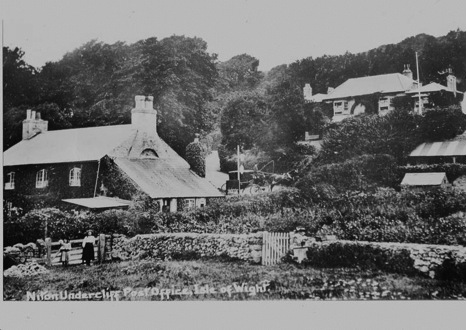 Early history and use
Rock Cottage was built as an outbuilding of the Royal Sandrock Hotel, known locally as “the Sandrock”. The cottage is the only surviving intact structure from the hotel buildings and its history is interwoven with the hotel.
Sandrock Hotel title deeds
Deeds for the hotel are held at the County Record Office, Newport. The deeds are a record of dealings in the legal title to the hotel, its land and its outbuildings between 1793 and 1883. They are difficult to interpret because most are hand written in the archaic legal language employed by conveyancers, extremely wordy and lacking punctuation. Others are the so called “abstracts” of title, the lengthy annotated summaries of the history of legal title to land used by solicitors to aid the interpretation and sale of unregistered land and passed with the title deeds¹.
Understanding the origin of the cottage is further confused by the fact that the hotel was originally known as “Rock Cottage” and its name evolved over its life as an hotel from the Sand Rock Spring Hotel, the Sandrock Hotel (the name by which it was known to Queen Victoria), the Royal Sandrock Hotel and finally the Royal Sandrock Inn.
The land on which the hotel was built (part of the field known as Cowe Close) is shown as being subject to a £50 mortgage in March 1793 but with no reference to any buildings on the site. Within two years (15 February 1795) a further mortgage document describes it as containing a “messuage” (that is a dwelling) and other buildings as “newly erected”, thereby supporting the view that the hotel building was constructed in or around 1794².
First mention of Rock Cottage in the deeds
Early history and use
Rock Cottage was built as an outbuilding of the Royal Sandrock Hotel, known locally as “the Sandrock”. The cottage is the only surviving intact structure from the hotel buildings and its history is interwoven with the hotel.
Sandrock Hotel title deeds
Deeds for the hotel are held at the County Record Office, Newport. The deeds are a record of dealings in the legal title to the hotel, its land and its outbuildings between 1793 and 1883. They are difficult to interpret because most are hand written in the archaic legal language employed by conveyancers, extremely wordy and lacking punctuation. Others are the so called “abstracts” of title, the lengthy annotated summaries of the history of legal title to land used by solicitors to aid the interpretation and sale of unregistered land and passed with the title deeds¹.
Understanding the origin of the cottage is further confused by the fact that the hotel was originally known as “Rock Cottage” and its name evolved over its life as an hotel from the Sand Rock Spring Hotel, the Sandrock Hotel (the name by which it was known to Queen Victoria), the Royal Sandrock Hotel and finally the Royal Sandrock Inn.
The land on which the hotel was built (part of the field known as Cowe Close) is shown as being subject to a £50 mortgage in March 1793 but with no reference to any buildings on the site. Within two years (15 February 1795) a further mortgage document describes it as containing a “messuage” (that is a dwelling) and other buildings as “newly erected”, thereby supporting the view that the hotel building was constructed in or around 1794².
First mention of Rock Cottage in the deeds
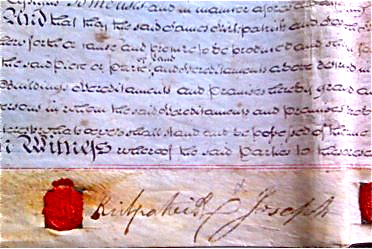 The question arises as to whether the cottage is the “other buildings” referred to in the 15th February 1795 document? The answer is unclear but it appears that the cottage was not built until later, upon the enlargement and conversion of the hotel building for use as an hotel (see below), and the first clear reference is a deed dated 10th October 1814. This mortgage document refers to a newly erected messuage and stables on the land to the north of the Springhead Butt - formerly part of the Buddle Homestead and to the south of the road. A plan of the site is helpfully included as part of the deed.
The plan shows, hatched red, the cottage in the north and the larger stable building to the South and marking in the bottom left corner the road “from Knowles” (i.e. Knowles Farm, to the west of the Lighthouse built later in 1840), in the top right the road or path “to Niton” and the lane (Buddle Lane) in the bottom right corner “to the Shore”.
The question arises as to whether the cottage is the “other buildings” referred to in the 15th February 1795 document? The answer is unclear but it appears that the cottage was not built until later, upon the enlargement and conversion of the hotel building for use as an hotel (see below), and the first clear reference is a deed dated 10th October 1814. This mortgage document refers to a newly erected messuage and stables on the land to the north of the Springhead Butt - formerly part of the Buddle Homestead and to the south of the road. A plan of the site is helpfully included as part of the deed.
The plan shows, hatched red, the cottage in the north and the larger stable building to the South and marking in the bottom left corner the road “from Knowles” (i.e. Knowles Farm, to the west of the Lighthouse built later in 1840), in the top right the road or path “to Niton” and the lane (Buddle Lane) in the bottom right corner “to the Shore”.
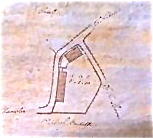 Copy of plan on deed dated 10 October 1814
The land to the north of the road is depicted as the “Hotel” and to the South, “Part of Buddle” (i.e. the Buddle Homestead, the oldest surviving structure in the vicinity, according to the recent owners³, built in 1601). We can therefore be reasonably confident that the cottage and stables were built between 1812 and 1814 as part of the process of commercialising the hotel. The cottage is referred to in early documents and prints simply as the “tap” (see below) and it is likely to have became known "Rock Cottage" later in the nineteenth century4.
Copy of plan on deed dated 10 October 1814
The land to the north of the road is depicted as the “Hotel” and to the South, “Part of Buddle” (i.e. the Buddle Homestead, the oldest surviving structure in the vicinity, according to the recent owners³, built in 1601). We can therefore be reasonably confident that the cottage and stables were built between 1812 and 1814 as part of the process of commercialising the hotel. The cottage is referred to in early documents and prints simply as the “tap” (see below) and it is likely to have became known "Rock Cottage" later in the nineteenth century4.
 It appears that the new owners then enlarged the building by adding two new wings. This extension work would have to have been during or after 1812, the date on a W.B. Cooke print showing the Sandrock in its smaller, wingless format.
It is W.B. Cooke who most clearly recites the origins of the hotel, stating5:
It appears that the new owners then enlarged the building by adding two new wings. This extension work would have to have been during or after 1812, the date on a W.B. Cooke print showing the Sandrock in its smaller, wingless format.
It is W.B. Cooke who most clearly recites the origins of the hotel, stating5:


 A detail from the plate in Vectis Scenery, ibid
A detail from the plate in Vectis Scenery, ibid
![]()


 Visit to the Sandrock of Queen (then Princess) Victoria
There are various accounts of Princess Victoria visiting the Sandrock and the reliability of some dates is questionable. Jacob Attrill is said21 to have been patronised by the Duchess of Kent and her daughter Princess Victoria and describes them as having made “frequent visits” to the Sandrock Hotel, which subsequently advertised its Royal prefix. We are fortunate that Queen Victoria maintained a journal for most of her life. Enquiries of the Senior Archivist of the Royal Archives, Windsor Castle, reveal that the Princess and her mother stayed at Norris Castle in 1831 and 1833 at Norris Castle in Whippingham near East Cowes, close to where she later built Osborne House with Prince Albert.
Visit to the Sandrock of Queen (then Princess) Victoria
There are various accounts of Princess Victoria visiting the Sandrock and the reliability of some dates is questionable. Jacob Attrill is said21 to have been patronised by the Duchess of Kent and her daughter Princess Victoria and describes them as having made “frequent visits” to the Sandrock Hotel, which subsequently advertised its Royal prefix. We are fortunate that Queen Victoria maintained a journal for most of her life. Enquiries of the Senior Archivist of the Royal Archives, Windsor Castle, reveal that the Princess and her mother stayed at Norris Castle in 1831 and 1833 at Norris Castle in Whippingham near East Cowes, close to where she later built Osborne House with Prince Albert.
 The Princess did not start writing her Journal until 1832, so we only have access to her Journal for her later visit to Norris Castle. One reference is made of the Princess’s visit to the Sandrock, on the 10th July, 1833:
The Princess did not start writing her Journal until 1832, so we only have access to her Journal for her later visit to Norris Castle. One reference is made of the Princess’s visit to the Sandrock, on the 10th July, 1833:



 The 1911 census form is signed by Arthur Butt (aged 37) who is a ‘carriage proprietor’ a
nd Annie his wife (also 37) is a telephone operator and so it appears that the cottage was still being used as the switchboard for the hotel
.
The 1911 census form is signed by Arthur Butt (aged 37) who is a ‘carriage proprietor’ a
nd Annie his wife (also 37) is a telephone operator and so it appears that the cottage was still being used as the switchboard for the hotel
.


